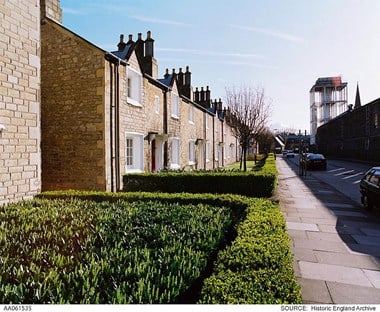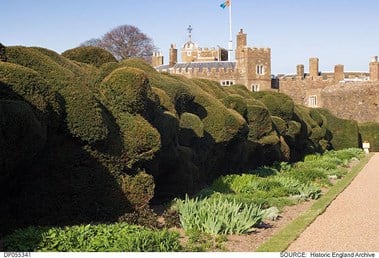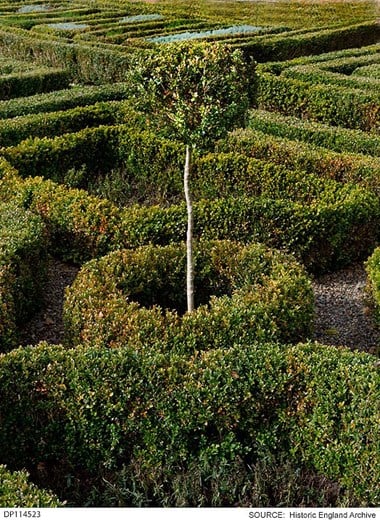Hedges
Hedges are varied. They are quintessential features of both our countryside and town gardens. They have many different functions, from marking boundaries to managing livestock or as garden design features. They also offer a wealth of wildlife habitats.
Origin of rural hedgerows
Hedges can originate in a number of ways. They may be woodland (assart) hedges, formed out of woodland trees/shrubs left as remnants after woodland clearance. They may derive from scrub growing on boundaries between cultivated fields or they may be planted with individual or a mix of species. Some may be a combination of different origins.
Dating hedgerows
In some areas, large numbers of hedges were planted as a result of the Enclosure Acts, the bulk of which were between 1760 and 1820 and in some instances the hedge itself may be protected by the specific Enclosure Act.
Some hedges may be much older than this. A formula has been developed for dating hedges based on the number of tree and shrub species per unit length. This is known as the ‘Hooper formula’. The number of tree and shrub species in a 30 metre length of hedge can indicate its age, with one species for each 100 years. A single species hedge is likely to be less than 100 years old whilst a 1,000 year old hedge is likely to contain ten to twelve species.
However, this formula must be used with caution. Hedges may have been planted with a mixture of species and there is geographical variation. In upland areas and the north of England hedge species are less diverse. There are also species of shrubs and herbs that are characteristic of old hedges or woodland, such as Spindle (Euonymus europaeus), Wild service (Sorbus torminalis) or Wood anemone (Anemone nemorosa).
Ecological value
Hedges support a range of flora in addition to the basic structure of trees and shrubs. This includes a number of climbing plants such as Honeysuckle (Lonicera periclymenum) and Ivy (Hedera helix) and ‘scramblers’ such as Dog-roses (Rosa canina) and Brambles (Rubus fruticosus) along with a wide range of herbaceous species growing in and around the base. This mix of species provides a source of nectar and pollen from early spring until well into winter, supporting a wide and varied range of insects.
Alongside flora, old hedges support a wide range of animal life, often similar to that found in woodlands, especially woodland margins. Hedges with trees and taller shrubs provide song posts and dense cover for nesting birds, while old trees provide holes for bats and birds as well as deadwood habitats for invertebrates. Hedges provide many species, particularly small mammals, with cover to move around an area.
The Defra Hedgerow Survey Handbook provides advice on surveying ecoligical value of hedges.
Hedgelink has more about the importance of hedgerows and management advice.
Traditional hedgerow management
The management of hedges depends on the aims of the site, the surrounding land uses, the nature conservation interest, and other considerations such as public access and the current physical state of the hedge.
Periodic traditional ‘laying’ will rejuvenate the hedge and regular trimming will encourage thick growth which will provide a stock-proof barrier. Every 15 years or so the hedge could be allowed to grow up tall and be re-laid. Different parts of Britain have historic and characteristic hedge laying styles and where possible a local style of hedge laying should be used. Information on traditional hedge management can be obtained from the National Hedgelaying Society.
Where necessary, hedges should be trimmed every second or third year, to allow the maximum number of hedge plants to flower and fruit. Any cutting should take place as late as possible (ideally February) so that the fruits and seeds are retained for winter birds but before the beginning of March when birds start nesting. If the hedge has to be cut early (for access or visibility) it should be left until birds have finished nesting at the end of August.
All wild birds and their nests (while being built or in use) are protected under the Wildlife and Countryside Act 1981.
Where possible not all the hedges on a site should be trimmed or laid in any one year, so that there are undisturbed areas for wildlife elsewhere on the site.
Garden hedges
The shape, height and form of garden hedges varies enormously. They are often part of the historic layout of gardens from suburban homes to grand country houses. Hedges are used as boundaries, and to create enclosures, entrances, parterre patterns, and provide screening and protection from wind and other intrusions. The tree species used for the hedging may also relate to the history of the garden.
Hedges need regular clipping or cutting to maintain their form and height. Very old, over-mature hedges or overgrown hedges can be rejuvenated or restored. The Royal Horticultural Society provides advice about planting, maintaining and renovating garden hedges. Hedges which have grown excessively high can cause problems between neighbours. See Hedge controls and consents below
Garden hedges image gallery
Please click on the gallery images to enlarge.
Hedge controls and consents
Below is some useful information and links on hedge controls and consents:
Hedges on scheduled monuments
Work to trees on a scheduled monument may require scheduled monument consent.
High hedges
Statutory regulations were introduced under the Anti-social Behaviour Act 2003 Part 8, to address the problem of neighbourly disputes over the height of boundary hedges. Redress under the regulations is only available to domestic properties but hedges on historic sites adjoining domestic properties may be the subject of action. The regulations only apply to hedges of evergreen or semi-evergreen species, hedges of deciduous species are not covered. More detail on the regulations and their use is given in ‘Over the Garden Hedge’.
Protected hedgerows
Some hedgerows are protected from removal by the 1997 Hedgerow Regulations.









